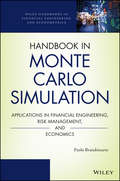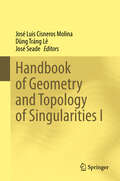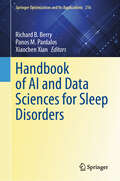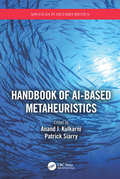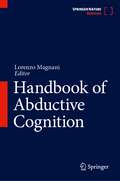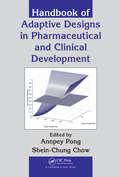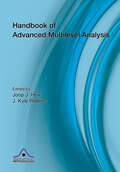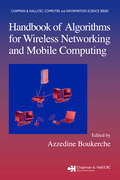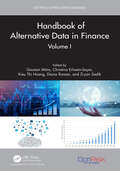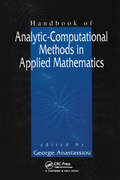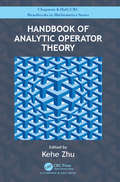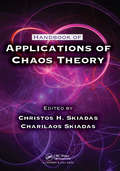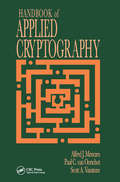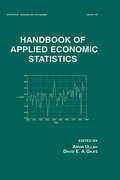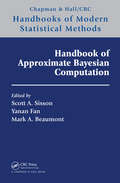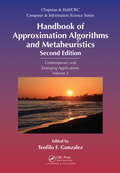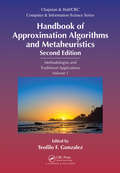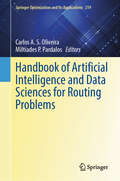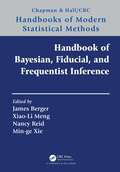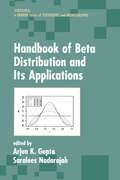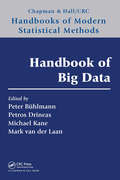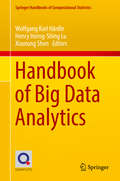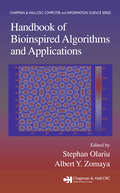- Table View
- List View
Handbook in Monte Carlo Simulation
by Paolo BrandimarteAn accessible treatment of Monte Carlo methods, techniques, and applications in the field of finance and economicsProviding readers with an in-depth and comprehensive guide, the Handbook in Monte Carlo Simulation: Applications in Financial Engineering, Risk Management, and Economics presents a timely account of the applicationsof Monte Carlo methods in financial engineering and economics. Written by an international leading expert in thefield, the handbook illustrates the challenges confronting present-day financial practitioners and provides various applicationsof Monte Carlo techniques to answer these issues. The book is organized into five parts: introduction andmotivation; input analysis, modeling, and estimation; random variate and sample path generation; output analysisand variance reduction; and applications ranging from option pricing and risk management to optimization.The Handbook in Monte Carlo Simulation features:An introductory section for basic material on stochastic modeling and estimation aimed at readers who may need a summary or review of the essentialsCarefully crafted examples in order to spot potential pitfalls and drawbacks of each approachAn accessible treatment of advanced topics such as low-discrepancy sequences, stochastic optimization, dynamic programming, risk measures, and Markov chain Monte Carlo methodsNumerous pieces of R code used to illustrate fundamental ideas in concrete terms and encourage experimentationThe Handbook in Monte Carlo Simulation: Applications in Financial Engineering, Risk Management, and Economics is a complete reference for practitioners in the fields of finance, business, applied statistics, econometrics, and engineering, as well as a supplement for MBA and graduate-level courses on Monte Carlo methods and simulation.
Handbook of Geometry and Topology of Singularities I
by Dũng Tráng Lê José Luis Cisneros Molina José SeadeThis volume consists of ten articles which provide an in-depth and reader-friendly survey of some of the foundational aspects of singularity theory. Authored by world experts, the various contributions deal with both classical material and modern developments, covering a wide range of topics which are linked to each other in fundamental ways. Singularities are ubiquitous in mathematics and science in general. Singularity theory interacts energetically with the rest of mathematics, acting as a crucible where different types of mathematical problems interact, surprising connections are born and simple questions lead to ideas which resonate in other parts of the subject. This is the first volume in a series which aims to provide an accessible account of the state-of-the-art of the subject, its frontiers, and its interactions with other areas of research. The book is addressed to graduate students and newcomers to the theory, as well as to specialists who can use it as a guidebook.
Handbook of AI and Data Sciences for Sleep Disorders (Springer Optimization and Its Applications #216)
by Panos M. Pardalos Richard B. Berry Xiaochen XianThe rise of lifestyle changes resulting from constant connectivity, irregular work schedules, heightened stress, and disruptive sleep patterns, have contributed to increasing insomnia rates. Exacerbated by the COVID-19 pandemic, sleep disorders are more prevalent than ever. This handbook offers a comprehensive exploration of the fusion of Artificial Intelligence (AI) and data science within the realm of sleep disorders, presenting innovative approaches to diagnosis, treatment, and personalized care. The interdisciplinary nature of this handbook fosters collaboration between experts from diverse fields, including computer science, engineering, neuroscience, medicine, public health, AI, data science, and sleep medicine. Each chapter delves into specific aspects of sleep disorder analysis, innovative methodologies, novel insights, and real-world applications that showcase the transformative potential of AI and data science in sleep medicine, from analyzing sleep patterns and predicting disorder risk factors to utilizing big data analytics for large-scale epidemiological studies. This handbook hopes to offer a comprehensive resource for researchers, clinicians, and policymakers striving to address the challenges in sleep medicine.
Handbook of AI-based Metaheuristics (Advances in Metaheuristics)
by Anand J. KulkarniAt the heart of the optimization domain are mathematical modeling of the problem and the solution methodologies. The problems are becoming larger and with growing complexity. Such problems are becoming cumbersome when handled by traditional optimization methods. This has motivated researchers to resort to artificial intelligence (AI)-based, nature-inspired solution methodologies or algorithms. The Handbook of AI-based Metaheuristics provides a wide-ranging reference to the theoretical and mathematical formulations of metaheuristics, including bio-inspired, swarm-based, socio-cultural, and physics-based methods or algorithms; their testing and validation, along with detailed illustrative solutions and applications; and newly devised metaheuristic algorithms. This will be a valuable reference for researchers in industry and academia, as well as for all Master’s and PhD students working in the metaheuristics and applications domains.
Handbook of Abductive Cognition
by Lorenzo MagnaniThis Handbook offers the first comprehensive reference guide to the interdisciplinary field of abductive cognition, providing readers with extensive information on the process of reasoning to hypotheses in humans, animals, and in computational machines. It highlights the role of abduction in both theory practice: in generating and testing hypotheses and explanatory functions for various purposes and as an educational device. It merges logical, cognitive, epistemological and philosophical perspectives with more practical needs relating to the application of abduction across various disciplines and practices, such as in diagnosis, creative reasoning, scientific discovery, diagrammatic and ignorance-based cognition, and adversarial strategies. It also discusses the inferential role of models in hypothetical reasoning, abduction and creativity, including the process of development, implementation and manipulation for different scientific and technological purposes. Written by a group of internationally renowned experts in philosophy, logic, general epistemology, mathematics, cognitive, and computer science, as well as life sciences, engineering, architecture, and economics, the Handbook of Abductive Cognition offers a unique reference guide for readers approaching the process of reasoning to hypotheses from different perspectives and for various theoretical and practical purposes. Numerous diagrams, schemes and other visual representations are included to promote a better understanding of the relevant concepts and to make concepts highly accessible to an audience of scholars and students with different scientific backgrounds.
Handbook of Adaptive Designs in Pharmaceutical and Clinical Development
by Shein-Chung Chow Annpey PongIn response to the US FDA's Critical Path Initiative, innovative adaptive designs are being used more and more in clinical trials due to their flexibility and efficiency, especially during early phase development. Handbook of Adaptive Designs in Pharmaceutical and Clinical Development provides a comprehensive and unified presentation of the princip
Handbook of Advanced Multilevel Analysis (European Association of Methodology Series)
by Joop J. HoxThis new handbook is the definitive resource on advanced topics related to multilevel analysis. The editors assembled the top minds in the field to address the latest applications of multilevel modeling as well as the specific difficulties and methodological problems that are becoming more common as more complicated models are developed. Each chapter features examples that use actual datasets. These datasets, as well as the code to run the models, are available on the book’s website http://www.hlm-online.com . Each chapter includes an introduction that sets the stage for the material to come and a conclusion. Divided into five sections, the first provides a broad introduction to the field that serves as a framework for understanding the latter chapters. Part 2 focuses on multilevel latent variable modeling including item response theory and mixture modeling. Section 3 addresses models used for longitudinal data including growth curve and structural equation modeling. Special estimation problems are examined in section 4 including the difficulties involved in estimating survival analysis, Bayesian estimation, bootstrapping, multiple imputation, and complicated models, including generalized linear models, optimal design in multilevel models, and more. The book’s concluding section focuses on statistical design issues encountered when doing multilevel modeling including nested designs, analyzing cross-classified models, and dyadic data analysis. Intended for methodologists, statisticians, and researchers in a variety of fields including psychology, education, and the social and health sciences, this handbook also serves as an excellent text for graduate and PhD level courses in multilevel modeling. A basic knowledge of multilevel modeling is assumed.
Handbook of Algorithms for Wireless Networking and Mobile Computing (Chapman & Hall/CRC Computer and Information Science Series)
by Azzedine BoukercheThe Handbook of Algorithms for Wireless Networking and Mobile Computing focuses on several aspects of mobile computing, particularly algorithmic methods and distributed computing with mobile communications capability. It provides the topics that are crucial for building the foundation for the design and construction of future generations of mobile and wireless networks, including cellular, wireless ad hoc, sensor, and ubiquitous networks. Following an analysis of fundamental algorithms and protocols, the book offers a basic overview of wireless technologies and networks. Other topics include issues related to mobility, aspects of QoS provisioning in wireless networks, future applications, and much more.
Handbook of Alternative Data in Finance, Volume I (CRC Press/OptiRisk Series in Finance)
by Gautam Mitra Christina Erlwein-Sayer Kieu Thi Hoang Diana Roman Zryan SadikHandbook of Alternative Data in Finance, Volume I motivates and challenges the reader to explore and apply Alternative Data in finance. The book provides a robust and in-depth overview of Alternative Data, including its definition, characteristics, difference from conventional data, categories of Alternative Data, Alternative Data providers, and more. The book also offers a rigorous and detailed exploration of process, application and delivery that should be practically useful to researchers and practitioners alike. Features Includes cutting edge applications in machine learning, fintech, and more Suitable for professional quantitative analysts, and as a resource for postgraduates and researchers in financial mathematics Features chapters from many leading researchers and practitioners
Handbook of Analytic Computational Methods in Applied Mathematics
by George AnastassiouWorking computationally in applied mathematics is the very essence of dealing with real-world problems in science and engineering. Approximation theory-on the borderline between pure and applied mathematics- has always supplied some of the most innovative ideas, computational methods, and original approaches to many types of problems. The f
Handbook of Analytic Operator Theory (CRC Press/Chapman and Hall Handbooks in Mathematics Series)
by Kehe ZhuHandbook of Analytic Operator Theory thoroughly covers the subject of holomorphic function spaces and operators acting on them. The spaces covered include Bergman spaces, Hardy spaces, Fock spaces and the Drury-Averson space. Operators discussed in the book include Toeplitz operators, Hankel operators, composition operators, and Cowen-Douglas class operators. <P><P>The volume consists of eleven articles in the general area of analytic function spaces and operators on them. Each contributor focuses on one particular topic, for example, operator theory on the Drury-Aversson space, and presents the material in the form of a survey paper which contains all the major results in the area and includes all relevant references. The overalp between this volume and existing books in the area is minimal. The material on two-variable weighted shifts by Curto, the Drury-Averson space by Fang and Xia, the Cowen-Douglas class by Misra, and operator theory on the bi-disk by Yang has never appeared in book form before. <P><P>Features: <li>The editor of the handbook is a widely known and published researcher on this topic <li>The handbook's contributors are a who's=who of top researchers in the area <li>The first contributed volume on these diverse topics
Handbook of Applications of Chaos Theory
by CHRISTOS H. SKIADAS AND CHARILAOS SKIADASIn addition to explaining and modeling unexplored phenomena in nature and society, chaos uses vital parts of nonlinear dynamical systems theory and established chaotic theory to open new frontiers and fields of study. Handbook of Applications of Chaos Theory covers the main parts of chaos theory along with various applications to diverse areas. Expert contributors from around the world show how chaos theory is used to model unexplored cases and stimulate new applications. Accessible to scientists, engineers, and practitioners in a variety of fields, the book discusses the intermittency route to chaos, evolutionary dynamics and deterministic chaos, and the transition to phase synchronization chaos. It presents important contributions on strange attractors, self-exciting and hidden attractors, stability theory, Lyapunov exponents, and chaotic analysis. It explores the state of the art of chaos in plasma physics, plasma harmonics, and overtone coupling. It also describes flows and turbulence, chaotic interference versus decoherence, and an application of microwave networks to the simulation of quantum graphs. The book proceeds to give a detailed presentation of the chaotic, rogue, and noisy optical dissipative solitons; parhelic-like circle and chaotic light scattering; and interesting forms of the hyperbolic prism, the Poincaré disc, and foams. It also covers numerous application areas, from the analysis of blood pressure data and clinical digital pathology to chaotic pattern recognition to economics to musical arts and research.
Handbook of Applied Cryptography (Discrete Mathematics and Its Applications)
by Paul C. van Oorschot Alfred J. Menezes Scott A. VanstoneCryptography, in particular public-key cryptography, has emerged in the last 20 years as an important discipline that is not only the subject of an enormous amount of research, but provides the foundation for information security in many applications. Standards are emerging to meet the demands for cryptographic protection in most areas of data communications. Public-key cryptographic techniques are now in widespread use, especially in the financial services industry, in the public sector, and by individuals for their personal privacy, such as in electronic mail. This Handbook will serve as a valuable reference for the novice as well as for the expert who needs a wider scope of coverage within the area of cryptography. It is a necessary and timely guide for professionals who practice the art of cryptography. The Handbook of Applied Cryptography provides a treatment that is multifunctional:It serves as an introduction to the more practical aspects of both conventional and public-key cryptography It is a valuable source of the latest techniques and algorithms for the serious practitioner It provides an integrated treatment of the field, while still presenting each major topic as a self-contained unit It provides a mathematical treatment to accompany practical discussions It contains enough abstraction to be a valuable reference for theoreticians while containing enough detail to actually allow implementation of the algorithms discussedNow in its third printing, this is the definitive cryptography reference that the novice as well as experienced developers, designers, researchers, engineers, computer scientists, and mathematicians alike will use.
Handbook of Applied Economic Statistics (Statistics: A Series of Textbooks and Monographs)
by Aman Ullah David E. A. GilesThis work examines theoretical issues, as well as practical developments in statistical inference related to econometric models and analysis. This work offers discussions on such areas as the function of statistics in aggregation, income inequality, poverty, health, spatial econometrics, panel and survey data, bootstrapping and time series.
Handbook of Approximate Bayesian Computation (Chapman & Hall/CRC Handbooks of Modern Statistical Methods)
by S. A. Sisson, Y. Fan and M. A. BeaumontAs the world becomes increasingly complex, so do the statistical models required to analyse the challenging problems ahead. For the very first time in a single volume, the Handbook of Approximate Bayesian Computation (ABC) presents an extensive overview of the theory, practice and application of ABC methods. These simple, but powerful statistical techniques, take Bayesian statistics beyond the need to specify overly simplified models, to the setting where the model is defined only as a process that generates data. This process can be arbitrarily complex, to the point where standard Bayesian techniques based on working with tractable likelihood functions would not be viable. ABC methods finesse the problem of model complexity within the Bayesian framework by exploiting modern computational power, thereby permitting approximate Bayesian analyses of models that would otherwise be impossible to implement. The Handbook of ABC provides illuminating insight into the world of Bayesian modelling for intractable models for both experts and newcomers alike. It is an essential reference book for anyone interested in learning about and implementing ABC techniques to analyse complex models in the modern world.
Handbook of Approximation Algorithms and Metaheuristics: Contemporary and Emerging Applications, Volume 2 (Chapman & Hall/CRC Computer and Information Science Series)
by Teofilo F. GonzalezHandbook of Approximation Algorithms and Metaheuristics, Second Edition reflects the tremendous growth in the field, over the past two decades. Through contributions from leading experts, this handbook provides a comprehensive introduction to the underlying theory and methodologies, as well as the various applications of approximation algorithms and metaheuristics. Volume 1 of this two-volume set deals primarily with methodologies and traditional applications. It includes restriction, relaxation, local ratio, approximation schemes, randomization, tabu search, evolutionary computation, local search, neural networks, and other metaheuristics. It also explores multi-objective optimization, reoptimization, sensitivity analysis, and stability. Traditional applications covered include: bin packing, multi-dimensional packing, Steiner trees, traveling salesperson, scheduling, and related problems. Volume 2 focuses on the contemporary and emerging applications of methodologies to problems in combinatorial optimization, computational geometry and graphs problems, as well as in large-scale and emerging application areas. It includes approximation algorithms and heuristics for clustering, networks (sensor and wireless), communication, bioinformatics search, streams, virtual communities, and more. About the Editor Teofilo F. Gonzalez is a professor emeritus of computer science at the University of California, Santa Barbara. He completed his Ph.D. in 1975 from the University of Minnesota. He taught at the University of Oklahoma, the Pennsylvania State University, and the University of Texas at Dallas, before joining the UCSB computer science faculty in 1984. He spent sabbatical leaves at the Monterrey Institute of Technology and Higher Education and Utrecht University. He is known for his highly cited pioneering research in the hardness of approximation; for his sublinear and best possible approximation algorithm for k-tMM clustering; for introducing the open-shop scheduling problem as well as algorithms for its solution that have found applications in numerous research areas; as well as for his research on problems in the areas of job scheduling, graph algorithms, computational geometry, message communication, wire routing, etc.
Handbook of Approximation Algorithms and Metaheuristics: Methologies and Traditional Applications, Volume 1 (Chapman & Hall/CRC Computer and Information Science Series)
by Teofilo F. GonzalezHandbook of Approximation Algorithms and Metaheuristics, Second Edition reflects the tremendous growth in the field, over the past two decades. Through contributions from leading experts, this handbook provides a comprehensive introduction to the underlying theory and methodologies, as well as the various applications of approximation algorithms and metaheuristics. Volume 1 of this two-volume set deals primarily with methodologies and traditional applications. It includes restriction, relaxation, local ratio, approximation schemes, randomization, tabu search, evolutionary computation, local search, neural networks, and other metaheuristics. It also explores multi-objective optimization, reoptimization, sensitivity analysis, and stability. Traditional applications covered include: bin packing, multi-dimensional packing, Steiner trees, traveling salesperson, scheduling, and related problems. Volume 2 focuses on the contemporary and emerging applications of methodologies to problems in combinatorial optimization, computational geometry and graphs problems, as well as in large-scale and emerging application areas. It includes approximation algorithms and heuristics for clustering, networks (sensor and wireless), communication, bioinformatics search, streams, virtual communities, and more. About the Editor Teofilo F. Gonzalez is a professor emeritus of computer science at the University of California, Santa Barbara. He completed his Ph.D. in 1975 from the University of Minnesota. He taught at the University of Oklahoma, the Pennsylvania State University, and the University of Texas at Dallas, before joining the UCSB computer science faculty in 1984. He spent sabbatical leaves at the Monterrey Institute of Technology and Higher Education and Utrecht University. He is known for his highly cited pioneering research in the hardness of approximation; for his sublinear and best possible approximation algorithm for k-tMM clustering; for introducing the open-shop scheduling problem as well as algorithms for its solution that have found applications in numerous research areas; as well as for his research on problems in the areas of job scheduling, graph algorithms, computational geometry, message communication, wire routing, etc.
Handbook of Artificial Intelligence and Data Sciences for Routing Problems (Springer Optimization and Its Applications #219)
by Carlos A. S. Oliveira Miltiades P. PardalosThis handbook delves into the rapidly evolving field of artificial intelligence and optimization, focusing on the intersection of machine learning, combinatorial optimization, and real-world applications in transportation and network design. Covering an array of topics from classical optimization problems such as the Traveling Salesman Problem and the Knapsack Problem, to modern techniques including advanced heuristic methods, Generative Adversarial Networks, and Variational Autoencoders, this book provides a roadmap for solving complex problems. The included case studies showcase practical implementations of algorithms in predicting route sequences, traffic management, and eco-friendly transportation. This comprehensive guide is essential for researchers, practitioners, and students interested in AI and optimization. Whether you are a researcher seeking standard approaches or a professional looking for practical solutions to industry challenges, this book offers valuable insights into modern AI algorithms.
Handbook of Automated Scoring: Theory into Practice (Chapman & Hall/CRC Statistics in the Social and Behavioral Sciences)
by Duanli Yan André A. Rupp Peter W. Foltz"Automated scoring engines […] require a careful balancing of the contributions of technology, NLP, psychometrics, artificial intelligence, and the learning sciences. The present handbook is evidence that the theories, methodologies, and underlying technology that surround automated scoring have reached maturity, and that there is a growing acceptance of these technologies among experts and the public." From the Foreword by Alina von Davier, ACTNext Senior Vice President Handbook of Automated Scoring: Theory into Practice provides a scientifically grounded overview of the key research efforts required to move automated scoring systems into operational practice. It examines the field of automated scoring from the viewpoint of related scientific fields serving as its foundation, the latest developments of computational methodologies utilized in automated scoring, and several large-scale real-world applications of automated scoring for complex learning and assessment systems. The book is organized into three parts that cover (1) theoretical foundations, (2) operational methodologies, and (3) practical illustrations, each with a commentary. In addition, the handbook includes an introduction and synthesis chapter as well as a cross-chapter glossary.
Handbook of Bayesian Variable Selection (Chapman & Hall/CRC Handbooks of Modern Statistical Methods)
by Mahlet G. TadesseBayesian variable selection has experienced substantial developments over the past 30 years with the proliferation of large data sets. Identifying relevant variables to include in a model allows simpler interpretation, avoids overfitting and multicollinearity, and can provide insights into the mechanisms underlying an observed phenomenon. Variable selection is especially important when the number of potential predictors is substantially larger than the sample size and sparsity can reasonably be assumed. The Handbook of Bayesian Variable Selection provides a comprehensive review of theoretical, methodological and computational aspects of Bayesian methods for variable selection. The topics covered include spike-and-slab priors, continuous shrinkage priors, Bayes factors, Bayesian model averaging, partitioning methods, as well as variable selection in decision trees and edge selection in graphical models. The handbook targets graduate students and established researchers who seek to understand the latest developments in the field. It also provides a valuable reference for all interested in applying existing methods and/or pursuing methodological extensions. Features: • Provides a comprehensive review of methods and applications of Bayesian variable selection. • Divided into four parts: Spike-and-Slab Priors; Continuous Shrinkage Priors; Extensions to various Modeling; Other Approaches to Bayesian Variable Selection. • Covers theoretical and methodological aspects, as well as worked out examples with R code provided in the online supplement. • Includes contributions by experts in the field.
Handbook of Bayesian, Fiducial, and Frequentist Inference (ISSN)
by James BergerThe emergence of data science, in recent decades, has magnified the need for efficient methodology for analyzing data and highlighted the importance of statistical inference. Despite the tremendous progress that has been made, statistical science is still a young discipline and continues to have several different and competing paths in its approaches and its foundations. While the emergence of competing approaches is a natural progression of any scientific discipline, differences in the foundations of statistical inference can sometimes lead to different interpretations and conclusions from the same dataset. The increased interest in the foundations of statistical inference has led to many publications, and recent vibrant research activities in statistics, applied mathematics, philosophy and other fields of science reflect the importance of this development. The BFF approaches not only bridge foundations and scientific learning, but also facilitate objective and replicable scientific research, and provide scalable computing methodologies for the analysis of big data. Most of the published work typically focusses on a single topic or theme, and the body of work is scattered in different journals. This handbook provides a comprehensive introduction and broad overview of the key developments in the BFF schools of inference. It is intended for researchers and students who wish for an overview of foundations of inference from the BFF perspective and provides a general reference for BFF inference.Key Features: Provides a comprehensive introduction to the key developments in the BFF schools of inference Gives an overview of modern inferential methods, allowing scientists in other fields to expand their knowledge Is accessible for readers with different perspectives and backgrounds
Handbook of Beta Distribution and Its Applications (Statistics: A Series of Textbooks and Monographs)
by Arjun K. Gupta Saralees NadarajahA milestone in the published literature on the subject, this first-ever Handbook of Beta Distribution and Its Applications clearly enumerates the properties of beta distributions and related mathematical notions. It summarizes modern applications in a variety of fields, reviews up-and-coming progress from the front lines of statistical research and
Handbook of Big Data (Chapman & Hall/CRC Handbooks of Modern Statistical Methods)
by Michael Kane Peter Bühlmann Petros Drineas Mark van der LaanHandbook of Big Data provides a state-of-the-art overview of the analysis of large-scale datasets. Featuring contributions from well-known experts in statistics and computer science, this handbook presents a carefully curated collection of techniques from both industry and academia. Thus, the text instills a working understanding of key statistical
Handbook of Big Data Analytics (Springer Handbooks Of Computational Statistics Ser.)
by Wolfgang Karl Härdle Henry Horng-Shing Lu Xiaotong ShenAddressing a broad range of big data analytics in cross-disciplinary applications, this essential handbook focuses on the statistical prospects offered by recent developments in this field. To do so, it covers statistical methods for high-dimensional problems, algorithmic designs, computation tools, analysis flows and the software-hardware co-designs that are needed to support insightful discoveries from big data. The book is primarily intended for statisticians, computer experts, engineers and application developers interested in using big data analytics with statistics. Readers should have a solid background in statistics and computer science.
Handbook of Bioinspired Algorithms and Applications
by Albert Y. Zomaya Stephan OlariuThe mystique of biologically inspired (or bioinspired) paradigms is their ability to describe and solve complex relationships from intrinsically very simple initial conditions and with little or no knowledge of the search space. Edited by two prominent, well-respected researchers, the Handbook of Bioinspired Algorithms and Applications reveals the
